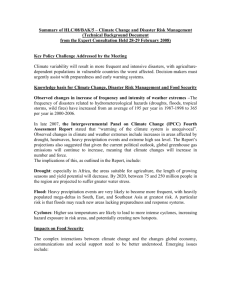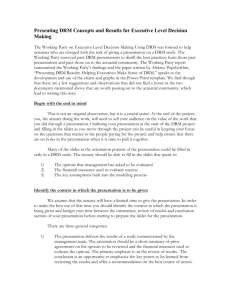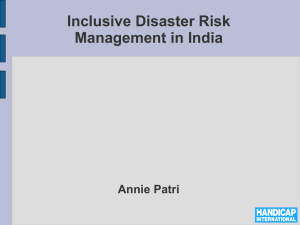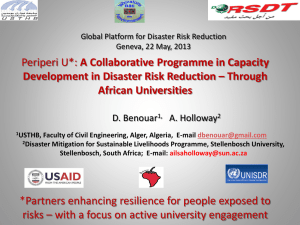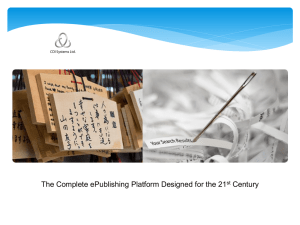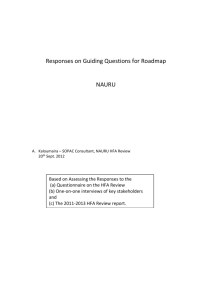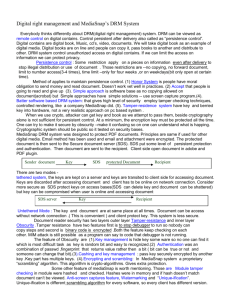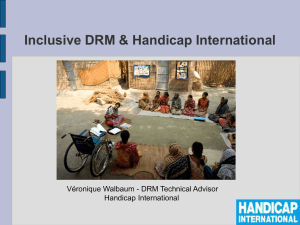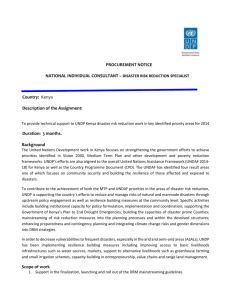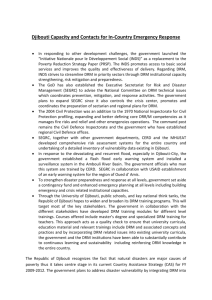Urban Risk. Earthquake Megacities Initiative
advertisement
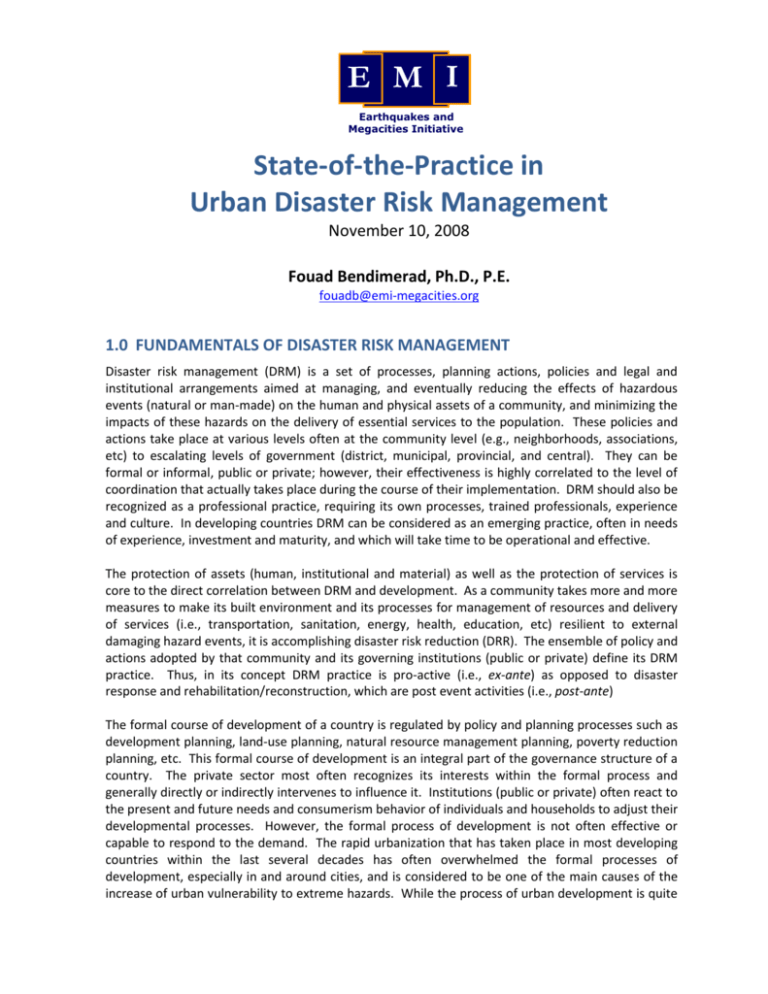
E M I Earthquakes and Megacities Initiative State-of-the-Practice in Urban Disaster Risk Management November 10, 2008 Fouad Bendimerad, Ph.D., P.E. fouadb@emi-megacities.org 1.0 FUNDAMENTALS OF DISASTER RISK MANAGEMENT Disaster risk management (DRM) is a set of processes, planning actions, policies and legal and institutional arrangements aimed at managing, and eventually reducing the effects of hazardous events (natural or man-made) on the human and physical assets of a community, and minimizing the impacts of these hazards on the delivery of essential services to the population. These policies and actions take place at various levels often at the community level (e.g., neighborhoods, associations, etc) to escalating levels of government (district, municipal, provincial, and central). They can be formal or informal, public or private; however, their effectiveness is highly correlated to the level of coordination that actually takes place during the course of their implementation. DRM should also be recognized as a professional practice, requiring its own processes, trained professionals, experience and culture. In developing countries DRM can be considered as an emerging practice, often in needs of experience, investment and maturity, and which will take time to be operational and effective. The protection of assets (human, institutional and material) as well as the protection of services is core to the direct correlation between DRM and development. As a community takes more and more measures to make its built environment and its processes for management of resources and delivery of services (i.e., transportation, sanitation, energy, health, education, etc) resilient to external damaging hazard events, it is accomplishing disaster risk reduction (DRR). The ensemble of policy and actions adopted by that community and its governing institutions (public or private) define its DRM practice. Thus, in its concept DRM practice is pro-active (i.e., ex-ante) as opposed to disaster response and rehabilitation/reconstruction, which are post event activities (i.e., post-ante) The formal course of development of a country is regulated by policy and planning processes such as development planning, land-use planning, natural resource management planning, poverty reduction planning, etc. This formal course of development is an integral part of the governance structure of a country. The private sector most often recognizes its interests within the formal process and generally directly or indirectly intervenes to influence it. Institutions (public or private) often react to the present and future needs and consumerism behavior of individuals and households to adjust their developmental processes. However, the formal process of development is not often effective or capable to respond to the demand. The rapid urbanization that has taken place in most developing countries within the last several decades has often overwhelmed the formal processes of development, especially in and around cities, and is considered to be one of the main causes of the increase of urban vulnerability to extreme hazards. While the process of urban development is quite complex and, sometimes resorts to ad-hoc action, the link of DRM to development cannot be incidental. Independently of where it takes place (community, local, provincial or national) DRM practices are more sustainable and more efficient in the long term when they are explicitly integrated with formal development processes. DRM practices should aim at strengthening the formal course of development, and not further weaken it in order to positively affect human, physical and institutional vulnerability. The introduction of DRM as an integrated element of the core functions and operations of government establishes the critical link to governance. The aim of reaching the integration of DRM in institutional planning, development, functional and operational processes is referred to as “mainstreaming”. Advances in disaster risk reduction (DRR) are directly linked to the ability of institution to accomplish mainstreaming. Developmental processes and program of government typically get implemented at the local level. One must thus recognize the key role of local government and local institutions in accomplishing the mainstreaming process. A country cannot reach an effective level for disaster risk reduction if its local processes and capacities for integration of DRM in developmental processes are weak or uncoordinated. Decentralization of planning processes, decision making processes and resources are strong indicators of the potential for mainstreaming. There are strong complementarities between humanitarian action and DRM. Both recognize the need to affect governance and the importance of a participatory process and social mobilization. Humanitarian action’s primary goal is the protection and enhancement of livelihoods and the betterment of the daily living conditions of individuals and communities.. On the other hand, DRM’s main goal is the protection of assets (human and physical) and services from major external shocks such as natural hazards. Humanitarian strategies have a strong base in community-based actions and have influenced DRM practice. As a result, a significant percentage of the investment in DRM has been in community based approaches1. Following the adoption of the HFA however, a stronger emphasis in institutionally based approaches has emerged. In particular, HFA’s five action oriented axes are indicated as strategies to guide governments in terms of mainstreaming DRM in their developmental practices. However, coming on the two-year anniversary of the HFA, the general consensus is that the integration of DRM in formal and informal developmental processes has been slow. One of the reasons is that the processes of development are complex and vary from country to country. Hence, the current tools and methods are not very efficient in accomplishing the process of mainstreaming. For example, participatory processes (such as community-based approaches) are seldom linked to the formal processes of development and/or anchored in policies, laws, regulations and practices that control development, as a result their long term influence on these processes is debatable. In contrast, the experience from the environmental field can be very relevant, as in most countries, environmental protection and adaptation is accepted as an important component of developmental planning. Post-event disaster response, recovery and reconstruction offer opportunities for improving DRM practices. However, that by itself is insufficient to achieve mainstreaming of DRM. Waiting for a disaster to strike to start undertaking DRM has long been recognized as a flawed policy. It remains that an understanding of the linkages and differences between DRM and humanitarian practices and DRM and disaster response planning could lead to more effective strategies in the 1 Most funding organizations still have their DRM functions within their humanitarian department. Urban DRM: State-of-the-Practice Page 2 governance requirements for DRM. DRM practice is in need of strategies, planning processes and implementation methodologies that are more explicitly correlated to developmental processes. 2.0 HOW IS DRR ACCOMPLISHED? DRR is an overlap between three broad actions: An analysis of the risk elements. This starts with an assessment of the risks and is continued by and analysis of these risks as they relate to the various assets and services that underlie the socioeconomic conditions of a community (e.g., transportation, or health care delivery, or education, etc.). Risk in itself is a convolution of the hazards that could affect a particular community, the vulnerability (or fragility) of the exposed assets (including human, material and institutional) to these hazards, and the capacity of the community to plan, cope and recover from any unforeseen shock. Several techniques exist and are used in the identification, assessment and analysis of risk. They encompass simple empirical techniques to very complex analytical scientific and engineering approaches. 2. The existence and effectiveness of the policies, strategies and planning processes for the management of the risks and the inter-coordination mechanisms for the implementation of these policies and their resulting programs 3. The communication and understanding of the risk and the risk management practices to the public and the various institutions that serve the public. 1. This is represented schematically in Figure 1. Achieving an understanding of risk through a risk assessment constitutes the first step and builds the foundations for the management of the risk. The risk analysis step consists of translating risk assessment parameters into an understanding of the impacts on population, infrastructure, essential services, and other essential functions and operations that enable urban life to function. It also includes the assessment of the capacities of communities and institutions to cope, respond and recover, and the resulting gaps and needs. It further deals with the development of indicators and other disaster management tools. The risk management function consists of the planning actions and policies necessary to manage risk. The risk communication function encompasses education, awareness, advocacy and empowerment of stakeholders to mobilize the social capital of the community. DRR is a dynamic process not a product that takes time and experience to implement, and which depends on the specific conditions present at the time. As any process, it must be evaluated and adjusted accordingly. Undertaking one single element alone does not necessarily result in disaster risk reduction. It is the overlap of the undertaking of all three that results in mainstreaming DRM practices and in reducing risk. The notion of “integrated” disaster risk management can be seen through this schematic description, the outcome of which is embodied in mainstreaming. Urban DRM: State-of-the-Practice Page 3 Fig. 1 Schematic Diagram showing sequencing and overlap of elements resulting in risk reduction Risk Assessment Risk Analysis Risk Management Risk Reduction Outcome Risk Communication 3.0 URBAN GOVERNANCE STRUCTURES An urban setting is often recognized through the administrative unit of a “city”, which is managed by a City Council under the leadership of a Mayor. The City Council approves the budget and policies of the City on behalf of its population, and provides oversight over the executive branch. The Executive governs through a series of laws, ordinances, decrees, and executive orders that have been adopted by the City Council and which are in conformity with the laws and regulation of the Country. A city has several administrative departments that render services to the population such as Public Works, Urban Development, Sanitation and Waste Management, Social Services, etc. Depending on the type of governance, a City may have jurisdiction over land use, health care, and education. The City itself can be sub-divided into smaller geo-political areas (districts, wards, burroughs), which can have their own administrative/political authority. Urban sprawl and unplanned urbanization have also resulted in areas of less formal boundaries and or transient population (e.g., migrant workers) that may move in and out of a city seeking work opportunities. These communities are often at high risk, but at the same pose specific challenges in DRM planning as they tend to fall outside the formal processes of urban governance. As the size of its population increases, a City typically become an agglomerate of several adjoining cities, which brings the need for a metropolitan authority to manage shared services such as transportation, land use, public works, utilities, and to act as a coordinator and power broker. Thus, in a metropolitan environment there could be as much as three levels of local government structures (i.e., district, city and municipality), notwithstanding the Provincial government, which is typically another executive branch that represent the “State” executive authority in a geographical region composed of several cities. Thus, the urban administrative structure could be quite complex in the way mandates, responsibility, authority and policy and decision-making take place. This is especially true for megacities and other large urban conglomerations. When one looks at the analysis of DRM practice, it is critical to recognize and understand this context. It is particularly important to understand how the governance structure of the country assigns responsibility over development planning, resource management Urban DRM: State-of-the-Practice Page 4 planning, land-use planning, emergency management, public works and the delivery of services and utilities. In general, a decentralized governance structure that locates planning and decision-making at the local level is much more amenable to mainstreaming DRM than a centralized governance structure because mainstreaming relies on integration, collaborative decision-making, and intersectoral coordination—all practices which decentralization fosters in local governments. Threat to development and social progress – Large cities and megacities are often the centers of political and economic development, wielding tremendous regional influence. Urban risk, especially risk to large metropolises, threatens the entire economic, political and social life of countries and places the well-being of a country, and a region at stake. Disasters disrupt business and commerce, waste resources of all kinds, set back development, and sabotage efforts to alleviate poverty, generate wealth, and improve the living standards of a community. Compounding effect on the poor and the more vulnerable - The ‘every-day risk’ of the urban poor from malnutrition, inadequate health care, substandard housing, unemployment, and illiteracy is compounded by disaster risk, because the poor are highly vulnerable to disasters. In the process of rampant urbanization, the world has seen a runaway growth of marginal settlements or slums, characterized by overcrowding, poor or informal housing, inadequate access to safe water and sanitation, and insecurity of land and property tenure. UN researchers estimate that there were at least 921 million slum dwellers in 2001 and more than 1 billion in 2005, with slum populations growing by a staggering 25 million per year. Slums are magnets for migrants who come to cities aspiring for a better future, and are often located in hazardous areas. 4.0 VULNERABILITY OF THE URBAN ENVIRONMENT Several elements contribute to urban vulnerability. It is their compounding and correlated effects that make urban disaster risk reduction a challenge. These elements can be grouped into the following vulnerability attributes: Unplanned urbanization is having increasingly devastating effects - Rapidly exploding growth of cities is overwhelming government institutions with the pressures of urbanization. With cities expanding so rapidly, much of the growth is haphazard, far exceeding the cities’ capacity to adequately plan and control development. As a result, uncontrolled urbanization often feeds the growth of slums, reinforces poverty, and diminishes cities’ ability to deal with disasters. The urbanization has taken place without regard to protecting against extreme hazard events. Faced with the needs to provide housing infrastructure and services, cities developed haphazardly and often without any formal land use and urban planning process. When these elements exist, they are typically oriented towards optimization of land, and seldom incorporate any disaster risk management parameters. Migration aggravates the problem by creating large scale informal construction. Migrants also face significant challenges in adapting their past experience and coping strategies to the new risk environment in cities. Social and Physical Degradation- New migrants and the underprivileged move into inner city neighborhoods where buildings are old and in poor maintenance conditions; access roads are narrow and service delivery is difficult. These old buildings and the aging infrastructure constitute a constant Urban DRM: State-of-the-Practice Page 5 threat to their occupants from hazards such as fires, floods and earthquakes. A significant proportion of urban dwellers resides and/or works in these highly vulnerable buildings where they are at high risk from multiple hazards and where access for emergency vehicles is often difficult and can be completely obstructed by building debris in case of a hazard event. Solutions to reduce social and physical vulnerabilities are socially, politically and financially difficult to devise and implement. Reducing the social and physical vulnerability of these neighborhoods remains a formidable challenge to the authorities. Urban risk has been neglected - Urban risk from extreme hazards has largely been ignored by local authorities; compounding the problem, cities have largely and chronically been neglected by national governments and international organizations. The premise has been that cities, especially megacities, have the capacity to address risk on their own; however, it is now clear that most cities, particularly in the developing world, are not effectively managing their risk. The validity of such a premise needs to be revisited as it is challenged by the ever increasing evidence of social and physical urban vulnerabilities. Schools, hospitals, essential facilities, housing, commercial and institutional property continue to be designed and built with little regards to the safety to extreme hazards such as earthquakes and floods. Structural vulnerability studies undertaken in large cities around the world indicate a high vulnerability of existing built environment to natural hazards. Urban disasters, particularly earthquakes have over and over demonstrated the precarious conditions of the built environment in cities. The physical vulnerability of existing environment constitutes one of the biggest threats to urban populations. Damages from climate change will accelerate as the world gets warmer - The consequences of climate change will become disproportionately more damaging with increased warming. Higher temperatures will increase the chance of triggering abrupt and large-scale changes that lead to regional disruption, migration and conflict. Warming may induce sudden shifts in regional weather patterns such as the monsoon rains in South Asia or the El Niño phenomenon. Climate change is aggravating the impact of climate-related hazards particularly related to temperature and precipitation changes, but also causing new emerging ones related to environmental health risks. The impacts of climate change are particularly worrying for urban regions and are likely to compound their existing vulnerabilities. 1.2 billion people now live along low lying coastal areas, many living within the world’s booming megacities. Climate change presents very serious global risks with profound long-term implications for these cities, not least because there now exists a ‘commitment’ to sea level rises of at least 50 centimeters by 2050 which could well bring with it increased storm and flood damage, increased coastal erosion, and salination of surface and ground waters. There are also a number of cities facing serious shortages of water supply as a result of increasing patterns of drought. Urban DRM: State-of-the-Practice Page 6 FIGURE 2 PROJECTED CLIMATE CHANGE (TOP, SOURCE: 4TH ASSESSMENT REPORT OF INTERGOVERNMENTAL PANEL ON CLIMATE CHANGE), AND ITS IMPACTS (BOTTOM, STERN REVIEW ON THE ECONOMICS OF CLIMATE CHANGE) The link between disaster risk reduction and adaptation to climate change It is now recognized that reducing disaster risk through the ‘Hyogo Framework for Action (HFA) is the key strategy for climate change adaptation. From the disaster risk reduction perspective there is growing recognition of two key ideas: the practical application of adaptation to climate change is risk reduction, and disaster risk reduction needs to take climate change into account. Efforts are however needed to build on these concepts and to focus more on local initiatives. As it stands, he HFA is primarily written by and for national international audiences. An equivalent set of guiding principles and planning tools are needed to orient local investment in DRR. n Weak institutional arrangements - In most developing countries, legislative and institutional arrangements inhibit rather than enable local action. While it is recognized that disasters are initially local events, accountability, authority and resources are not sufficiently decentralized to enable local governments to assume ownership and take actions to manage disaster risk effectively. The reversed “pyramid” of resources and responsibility between central authorities and local authorities Resources C e n t r a l P r o vi n c i a l L o c a l Responsibility EMI Lack of political feasibility - Politicians, administrators, and community leaders all face conflicting priorities, and DRR almost invariably takes the back seat to other needs which may be considered more pressing or easier to solve. Risk is not managed preemptively, but thought of in terms of something to be dealt with when disaster strikes, through emergency response and humanitarian assistance. Further, the lack of experience, methodology and standards make DRR an unattractive proposition for local officials. Urban DRM: State-of-the-Practice Page 7 Insufficient knowledge, experience and capacity - Disaster risk reduction is complex, and few administrators have experience in DRR implementation. It takes time, effort, tools, and training to assimilate disaster risk reduction in city functions and ongoing operations. Significant deficiencies remain throughout cities and megacities in terms of inter-institutional coordination, warning systems, incident command and control, resources for response, relief, recovery, and rehabilitation practice following urban disasters. An additional weakness relates to the project planning processes of government. While concepts are often understood and policies are in place, carrying these policies and concepts to practice is a major hurdle for government at all level. The process of project planning and execution needs to be recognized as a major weakness if progress in DRM has to be achieved. Even among cities which have shown competency in establishing planning processes to control their physical development, carrying these planning processes into project planning and execution remains a challenging step. Lack of Acceptable Standards of Practice DRM is a professional practice that still lacks its own set of acceptable standards of practice. This results in a dispersion of effort and an ineffective use of resources. It also erodes the political support for local level action on DRR. Providing tools to enable translating national policies into mainstreaming planning processes at the local level would help cities in understanding the options that are available to them for managing risks and for planning and implementing urban DRR. 5.0 TRENDS IN LOCAL-LEVEL DRM PRACTICE The list of initiatives and projects aimed at urban disaster risk reduction is too long to be reproduced here; the author cannot possibly be aware or knowledgeable about all the on-going efforts. Nonetheless, projects/initiatives are taking place at many levels. At the international level, U.N. organizations have launched several urban disaster risk reduction programs. Some of these programs have a global reach, such as for example GRIP (Global Risk Identification Program) http://www.gri-p.net/grip.php. While GRIP does not singularly target urban DRR, it seeks to improve information on risks and disaster losses. Similarly, the Global Facility for Disaster Risk Reduction (GFDRR) www.gfdrr.org has funded several projects globally aimed at urban DRR (e.g., Metro Manila, and Quito). Some of this funding is channeled through the World Bank country offices or through implementing partners. Similarly, with the support of its Bureau for Crisis Prevention and Recovery ( BCPR), UNDP has developed many projects aimed at urban DRR (e.g., Kathmandu, Metro Manila, Amman, Quito, Aqaba, Kerman and others), but also community based disaster preparedness and risk reduction through participation of communities and local governments( India), as well as regional efforts aimed at several urban agglomerations such as the Regional Strengthening and Disaster Risk Reduction in Major Cities in the Andean Communities which focuses on risk reduction efforts for the capital cities of five Andean countries (Bolivia, Ecuador, Venezuela, Peru and Colombia). Most notably, the Secretariat of the UN-ISDR has established two regional task forces for Urban Risk Reduction (One in Latin American and the Caribbean and the other one in Asia-Pacific). The Task Forces are already playing an important role in terms of coordinating urban DRR efforts and providing guidance and structure to the multitude of regional initiatives. Many governments have recognized the risk to their cities and initiated risk assessment, preparedness and in some cases mitigation programs. In particular, countries such as Turkey, Jordan, Urban DRM: State-of-the-Practice Page 8 Indonesia, Philippines, India, Uzbekistan, Ecuador and Colombia can be credited for having active national urban DRR programs. Local governments are increasingly more aware of the consequences of risks from natural and manmade hazards on their cities and localities and are actively improving their capacity to deal with such risks. Many cities have developed a comprehensive understanding of their exposure to hazards and have taken steps to improve their capabilities to respond and reduce disaster risks. Among the most dedicated cities, one notes Istanbul, Bogota, Tehran, Quito, Metro Manila, La Paz, Kathmandu, Mumbai and several others. Local government organizations are also taking a more active role in promoting urban DRR as part of sound governance practices among their members and associates. The Global Forum for Urban Disaster Reduction, which was launched at the First Global Platform (June 2007) as a broad forum of UN-Organizations, ISDR Secretariat, Local Government Organizations, Cities, ProVention Consortium and several other agencies and organizations is moving forward with awareness, capacity building and political actions from mayors and local authorities to indicate a commitment to urban DRR and to mobilize the engagement of local officials and professionals in DRR activities. To energize the Global Forum through specific advocacy, coordination and capacity building activities, UCLG (United Cities and Local Governments), METROPOLIS, CITYNET, ICLEI, ProVention Consortium and EMI recently formed the Partnership for Urban Risk Reduction (or PURR). The ISDR Secretariat has spearheaded a similar initiative under the Alliance for Local Government. This flurry of activities is certainly raising the attention on urban DRR. It is however too early to state what has been their global impact and efficiency. The lack of a systematic compilation and evaluation of these activities coupled with inefficiency in the mechanisms for sharing and coordinating, impair an objective evaluation. While progress has been accomplished and many cities are taking steps in terms of reducing their risks, the overwhelming majority of cities have not even reached the initial stage of recognizing their risk, so most of their initiatives have been to improve emergency response capabilities. Cities face tremendous challenges in terms of understanding and implementing sound DRM practices that could reduce their vulnerabilities and risks to extreme hazard events. 6.0 LIMITATIONS, ISSUES AND IMPEDIMENTS OF URBAN DRM PRACTICE P The Hyogo Framework for Action (HFA) and its related implementation guide “Putting Words into Action” offer a set of principles and suggested actions for countries to undertake in order to implement sound DRM practices and progressively achieve DRR. The HFA is presented as de-facto standards for government, as its credibility is established by the nature of the 168 countries that adopted it and ratified it. However, the HFA is written and directed towards central governments, and it is more difficult to implement in the context of local government. At this time, there are no substitutes for HFA that apply to the application of DRM practice at the local level. There is no lack of tools, approaches, methodologies; however none of these can be considered to be a “standard” of practice. The lack of a credible and accepted set of standards makes it difficult to have an objective identification and assessment of the various initiatives taking place in urban DRR. At the same time, there is a lack of coherency and complementarities of the on-going urban DRM initiatives, and no adequate means to measure their effectiveness in terms of pushing urban DRR forward. Undoubtedly, taken together, these initiatives are advancing the cause of urban DRR, but to which level each one of them is mainstreaming DRR remains difficult to establish since the explicit linkage between DRM and developmental processes remain weak. To illustrate this point, two widely used practices are discussed: Urban DRM: State-of-the-Practice Page 9 Hazard, Vulnerability and Risk Identification - There are several initiatives aimed at identifying and mapping hazard, vulnerability and risk. However, often these initiatives are not followed by a planning process to integrate the risk information into a formal land use planning process or construction code, or actual physical strengthening of infrastructure or services. For example, in many countries specialized agencies and academic studies often generate a significant amount of knowledge on risk; local and central governments also commission hazard, vulnerability and risk studies, but this body of knowledge often remains in the hands of a few experts and does not find its way into urban developmental planning and land use planning for example. Similarly, national societies of the Red Cross/Red Crescent Movement are promoting the undertaking of VCA’s (Vulnerability and Capacity Analysis). At the same time, communities are encouraged to establish alert systems to watch river flood levels and protect themselves against potential floods. Clearly, hazard and risk studies, VCA and community-level EWS’s are all aimed at vulnerability reduction. However, it is difficult to measure the effectiveness of these investments in accomplishing mainstreaming because the mechanisms to integrate this critical information into developmental planning processes are limited by the lack of coordination and the weaknesses in knowledge sharing opportunities. School Awareness Programs - School awareness programs have been undertaken for more than two decades, and have now been put in place in many countries. Teaching children about disasters and training them in terms of what to do before, during and after an earthquake is an essential awareness raising and preparedness activity for a country/community. But, evidence shows that in most cases, these awareness programs do not include efforts to identify the physical risks to the school facilities and to develop programs for structural reduction of risks when present. Recent disaster experiences show that in many countries, the earthquake vulnerability of schools is alarming. The same question arises: would school awareness programs be considered to be a DRR activity if they are not linked to a physical safety plan? The lack of standards coupled with the lack of a universally accepted definition of DRR result in an inefficient use of resources, inadequate strategies and poor coordination. A set of DRM standard can provide a more efficient approach to guide governments, public, private and community based organizations in framing their hazard, vulnerability and risk assessment actions within the context of development. Conceptual Limitations – Sound practice in DRM is recognized as an integrated inter-sectoral and inter-institutional activity. It is widely accepted that one of the principal impediments in implementing DRR resides in the difficulty for bureaucratic processes to devise and incorporate intersectoral arrangements and their related inter-institutional communication protocols. Government agencies typically struggle putting in place mechanisms for integrating DRR in development processes, because development activities are structured to take place at various levels of government and are strongly influenced by private sector intervention and individual and household consumerism behavior. It is easier for government to improve response capabilities than to undertake DRR. The principle for inter-sectoral integration is well accepted. However, in practice DRM approaches are often broken down into sectoral activities with little thought in terms of how these components should be integrated. Urban DRM: State-of-the-Practice Page 10 As an example, DRM is often described in the context of the so-called “Disaster Cycle”, where an event takes place, which then triggers response and recovery, which then calls for better reconstruction, and higher preparedness, which improves the understanding of risk, until the next event takes place. This approach stresses a “sequential” concept and not an integrated concept for DRR. The Disaster Cycle assumes that the integration takes place “naturally”. This assumption is flawed as demonstrated in practice. Mainstreaming requires a strategy that moves from an eventfocused approach to process-oriented and decision-making thinking. Mechanisms need to be put in place in order to enable integration. The same limitation is found into the HFA, which again segregates DRM practice into five separate planning actions: a) Legal and Institutional; b) Risk Knowledge; c) Education and Awareness; d) Risk Reduction, and e) Response Planning. While HFA does emphasize that these five items should be considered in an overall integrated national strategy, the actual practice shows that such integration is difficult to accomplish under such un-integrated concepts. These conceptual contradictions need to be recognized in order to devise a conceptual approach that inherently leads to mainstreaming by following an integrated model right at the conceptual level. 7.0 FRAMEWORK FOR SOUND DRM PRACTICE The challenge facing the implementation of DRR is that it is an emerging practice that is not understood by governments and is often trivialized in terms of the difficulties in putting it in practice. As discussed above, urban vulnerabilities stem from many causes, and the impediments to implementing DRR are often daunting. One must thus undertake the process of developing a DRM practice as a long term and well-planned endeavor. In the following a mainstreaming framework is proposed as a means to developing a DRM practice in cities. It is hinged on three elements: Local Implementation plus Central Coordination plus Participation. It recognizes the role of communities, and their governing institutions and calls for a participatory process in order to build knowledge, ownership and sustainability. Mainstreaming Framework – Recognizing that DRM implementation is essentially a local function can serve as a start for developing an integrated model for mainstreaming DRM. Local government typically has authority over a number of key services and functions that need to be made resilient to disturbing external hazard events in order to reduce urban vulnerability. These services include transportation, water and sanitation, engineering and public works, housing and building construction, land use and urban development, and social services. These are the base functions where mainstreaming needs to take place locally. However, local implementation cannot be done in a vacuum from the central agencies of the government, which have legal and institutional mandates and are in charge of oversight and resources. The role of the national government to provide the legal and institutional basis for DRM as well as to provide the resources and to ensure compliance is fundamental. However, it must understand the importance of local implementation and should be supportive of the concept of decentralized action. The dual effect of local implementation and central coordination is not sufficient by itself to achieve mainstreaming. These institutions must mobilize the social human and institutional resources of the communities though the participation of the stakeholders including the academia, private sector, trade and workers unions, professional organizations, media, community leaders and representatives, volunteers, networks and alliances, and various other representatives of civil society. CommunityUrban DRM: State-of-the-Practice Page 11 based approaches are good example of participatory processes, and so are methods such as VCA. The participatory process is crucial in terms of developing ownership, raising awareness, and creating an informed citizenry that works coherently with its leadership in making the socio-cultural and institutional transformations that enable mainstreaming. It links the top-down approach with the bottom up approach. This model shown graphically by the three boxes of Figure 3 was devised by the author and has been used by EMI (Earthquakes and Megacities Initiative) in guiding its DRM work with its city partners. The model however is not unique, and others can be devised. It merits discussion. It is however different in its concept from the sectoral approach of HFA or the cyclical approach behind the socalled “Disaster Cycle” model. Fig. 3 – An Example of Mainstreaming Model for Local-Level DRM (Local Implementation – Central Coordination – Participation) Source: Earthquakes and Megacities Initiative EMI (www.emi-megacities.org ) Need for Participatory Process The participatory approach is core to the notion of mainstreaming as a model for developing a DRM practice. The participatory process facilitates the communication of risk, the development of ownership, and the inter-sectoral coordination. It enables consensus building and social mobilization. It must be emphasized that the mainstreaming goal does not conceive the creation of new governmental structures, but rather the enabling of existing institutions in understanding and integrating DRR within their operations and functions. Thus, these institutions must be part of the discussions, strategic planning, and action planning processes. School safety programs cannot be successfully undertaken without the active participation of students, teachers, educators, parents, physical planners, social workers and community leaders. Difficult issues such as informal housing cannot be effectively resolved without the participation of the affected populations, the local policy makers, city planners, and community advocates. Adopting a structured participatory process is essential in achieving success in mainstreaming. Need for Acceptable Standards of Practice – As stated earlier in this paper, the lack of international standards of practice for urban DRM is a significant impediment to enabling mainstreaming. It negatively affects many aspects of policy, planning and implementation of DRR. The development of a globally acceptable and credible set of standards would make urban DRM a much more acceptable proposition for policy makers, since their Urban DRM: State-of-the-Practice Page 12 policies would be measured with respect to these standards. Overcoming the impediment of political infeasibility would be a great step forward. The standards will also provide institutions with a set of planning concepts and procedures and would thus align the institutional planning processes. They would also help to mobilize resources and provide guidance on capacity and competency development. Further, they would provide a framework for discussion and debate that would be much more efficient and constructive than the current environment. Indicators for Mainstreaming – A set of indicators with benchmark should measure progress on the implementation of the standards of practice. Indicators have an important role in facilitating risk communication, enabling decision-making and allocating resources. There are several efforts related to developing DRM indicators. Figure 4 provides a partial set of mainstreaming indicators that could be attached to local-level implementation of DRM. They are based on the concept of mainstreaming indicated above. Of course, this set of indicators is not unique, or comprehensive or ideal. However, it is consistent with the concept of mainstreaming of DRM at the local level. Fig. 4 Set of Suggested Indicators for Local-Level Mainstreaming Source: Earthquakes and Megacities Initiative (www.emi-megacities.org ) 8.0 TURNING CHALLENGES INTO OPPORTUNITIES Following approaches to deal with urban DRM presented as both challenges and opportunities for DRM. They can be segregated into short term and long term strategies. Attain more favorable legal and institutional arrangements - Decentralization can build more capable cities and local institutions. Many local governments have not had the necessary legal mandate and authority to play a major part in implementing policies and practices to meet their cities’ immediate and long-term disaster risk reduction needs. Success requires balance, so that cities acquire not only responsibility and accountability for disaster risk reduction but also the authority and resources to effectively carry it out. Reversing the “pyramid” of resources is the key to improved local governance and mainstreaming DRR policies and practices in government activities. Urban DRM: State-of-the-Practice Page 13 Systemic integration in land use planning and urban development - The difficulties of implementing urban disaster risk reduction will become less challenging if its elements are directly integrated in the cities planning process. Cities typically have established formal processes for land use planning, physical planning and urban development. Integrating DRM into these processes provide some of the most efficient mainstreaming strategies, and deserves more attention and investments. Providing skills and competency to urban planners in risk-sensitive land-use planning and incorporating these tools in to zoning and other land-use regulation is an achievable short term strategy. Improving the project planning and project execution capabilities of local government – Crossing the step from planning to project execution and review is a major hurdle for city governments. Investing in supporting local authorities in carrying their plans into project planning, execution and management would help reach positive accomplishments in DRR. Project planning, execution and management is typically a systemic weakness of the services of local authorities. For newly introduced activities such as DRM this process is even harder. Project execution and review is oftern underestimated, and requires multi-disciplinary skills and long term assistance to be developed. The standard for performance should not be in terms of how much plans have been developed, but how many activities of these plans have actually been successfully implemented. Reaching this standard requires an investment in both technical skills and in project management and execution skills of city governments. Urban redevelopment is a powerful tool to reduce urban risk - Reducing the vulnerability of existing building stock is considered one of the most complex urban risk reduction issues. Urban renovation and urban rejuvenation can increase the economic and social potential of older neighborhoods while reducing their risk by incorporating structural and non-structural mitigation measures. Risk-sensitive urban planning and development tools can provide more viable options to the political leaders, the residents and the business community to make informed decisions. The legal, social, political and economic factors associated with urban renovation can be quite challenging to resolve and will require compromises and leadership. Pilot studies can build experience and build a community of practice that is competent in undertaking such projects. Examples of Urban Renovation Projects Marikina City (Philippines). Marikina City’s flood mitigation program has dramatically decreased the flood exposure to residences, businesses, and essential facilities in the city. Continuously funded by local government, the project began in 1992 and has reduced the actual flooded area from 27.52% in 1992 to 19.04% in 2004 with 30% savings on the projected budget. In addition, to ensuring safer living, the project provides more open space and a cleaner environment as well as greater benefit to the business community. Source: Mega-Know www.emi-megacities.org/megaknow Urban DRM: State-of-the-Practice Page 14 Life-safety construction standards for every new building - The knowledge for building earthquakeresistant structures exists for more than 40 years. Yet, we continue to build thousands and thousands of buildings each year that constitute a life safety threat to their otherwise unaware occupants. Studies show that the cost of making buildings earthquake safe is no more than 5-10% of the construction cost. For instance, all new construction in Mumbai can be made earthquake resistant with a recurring additional investment of under US$10 million per year, representing no more than 5% of a buildings construction cost. Competent building codes and more importantly enforceable implementation processes have proven to be challenges to having disaster-resistant construction. However, many cities and countries are tackling this problem with success, and the issue is increasingly better understood by policy makers. Reducing human losses in the most exposed cities from preventable building collapses is a long term strategy that requires training, education and practice-proven legislative processes. Keeping Schools Safe in Earthquakes The enormous loss of life in collapsed schools around China's quake-stricken Sichuan Province in May 2008 could have been significantly reduced using known methods for designing or retrofitting structures in earthquake zones. In recent years, there have been deadly school collapses after earthquakes in Italy, Algeria, Morocco and Turkey. Most notably, in Pakistan on Oct. 8, 2005, at least 17,000 children died as more than 7,000 schools collapsed. A 2004 OECD study estimated for 10 risk-prone countries that 180 million people, including 40 million school-age children, face an earthquake risk equal to that of northern Pakistan. Raising the standard of care and work ethics - Local institutions can be strengthened by training and improving the skills of city practitioners and elevating their value in society. Professional and trade organizations can play an important role in improving the standards of practice by putting in place professional certification mechanisms for example. This short term strategy would build local ownership and can take place through better trained professionals and managers. Developing a culture of prevention _– A community well-being and self-reliance are strengthened through education and preparedness. A balanced program of community and institutional education and preparedness enhances welfare, safety, preparedness, stability, robustness, and self-reliance. Strategically, preparing for extreme hazards should not be considered as exceptional activities undertaken outside of the day-to-day concerns about the safety and welfare of communities instead they should be presented as an integral part of mobilizing social participation for the planning and implementation of development programs and poverty reduction initiatives. Vulnerable communities are often those that are the most disenfranchised from local governance processes. Communitybased efforts are opportunities to drive change toward DRR from the bottom-up. Linking communitybased DRM initiatives to local developmental processes will empower communities in terms of participating in and influencing the development process and will improve governance by improving accountability and transparency and reducing opportunism and corruption. As argued previously, these linkages must be explicit and part of an overall mainstreaming strategy. Improving international and regional cooperation - An effective strategy to DRR will require deeper international cooperation and a multi-stakeholder approach. The private sector should be engaged and challenged by governments and civil society to contribute to DRR through participation Urban DRM: State-of-the-Practice Page 15 in public policy debate and in public-private partnerships. It also requires partnership between cities, through international frameworks that support action for the achievement of shared goals. Resources must be generated – Inadequate resources and incentives compromise disaster risk reduction action. Disaster risk reduction is a long-term, low-visibility process, with little guarantee of tangible rewards in the short term, either for politicians in affected cities or for donors. However, inaction brings further complication of the problem and further accumulation of risk, creating the need for future investments that are significantly costlier than those needed now. Development projects should have budgetary allocations for hazard and vulnerability studies that look at long term sustainability. Sound practices examples should be compiled and studies undertaken to demonstrate that the benefits of strong, early action outweigh the costs. Convincing documentation on sound DRM applications that have improved the economic and social capital of communities needs to be undertaken and used as examples for other cities and communities. Policies to ensure that a portion of the emergency relief and reconstruction budget goes directly into long-term risk reduction should be promoted among donors and funding agencies. The need to establish an urban DRR practice goes beyond the noble humanitarian goal of saving lives. It defines the future of our cities in terms of the protection of their assets and the efficiency and capabilities of their services and governing structures. The most tangible incentives reside in mobilizing the human resources of communities and institutions. We must invest in developing the human potential for DRR through training of practitioners, competency buildings of professionals and decision makers, peer-to-peer sharing, and knowledge accessibility and valorisation of the human potential through recognition and dissemination of sound practices. Developing the human potential will enable communities and institutions to push the DRM practice forward. It would turn liability into assets and challenge into opportunity. ACKNOWLEDGEMENTS The author gratefully acknowledges the valuable input and comments provided by all those who took the time to review the paper including Ian O’Donnell Hossein Kalali, Bijan Khazai, Shirley Mattingly, and Friedemann Wenzel. Urban DRM: State-of-the-Practice Page 16 ANNEX 1 Cities and Disaster Risk For the first time in human history, the world urban population has exceeded its rural population. Urbanization is taking place at an unprecedented rate. In the next 20 years, the world’s population is predicted to increase by an additional two billion. Because of internal migration, from the countryside to cities, most of the additional 2 billion will be in cities of developing countries – in fact only 50 million will be added to the most developed countries. Eventually, cities will account for all future global population growth. By 2030 more than 60% of the world’s population are expected to live in cities, with record concentrations in large urban conglomerations and megacities in the developing world. Cities in more developed countries will double their population in 185 years, while cities in developing countries will reach twice their size in just 30 years, and account for 12 out of the largest 15 cities in the world by 2015. Cities vulnerability to disasters is on the rise especially as more poor people settle in high-risk urban areas. Losses from a major disaster in large cities and megacities will harm large populations both within and far beyond their boundaries. Unfortunately, the planning and development of cities has only given scant consideration to the consequences of hazards such as earthquake, floods, typhoons and others. Eight out of the ten most populous cities in the world can be severely affected by an earthquake, whereas six out of ten are vulnerable to storm surge and tsunami waves. Table 1. Trend in Urban Growth 1950-2030 World Urban Population 6.000.000 Population 5.000.000 4.000.000 3.000.000 2.000.000 1.000.000 World MDCs LDCs 0 1950 1960 1970 1980 1990 2000 2015 2030 Year Source: UN, World Urbanization Prospects, 2002. Urban DRM: State-of-the-Practice Page 17
